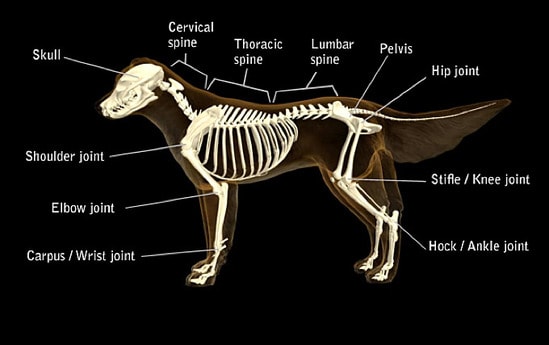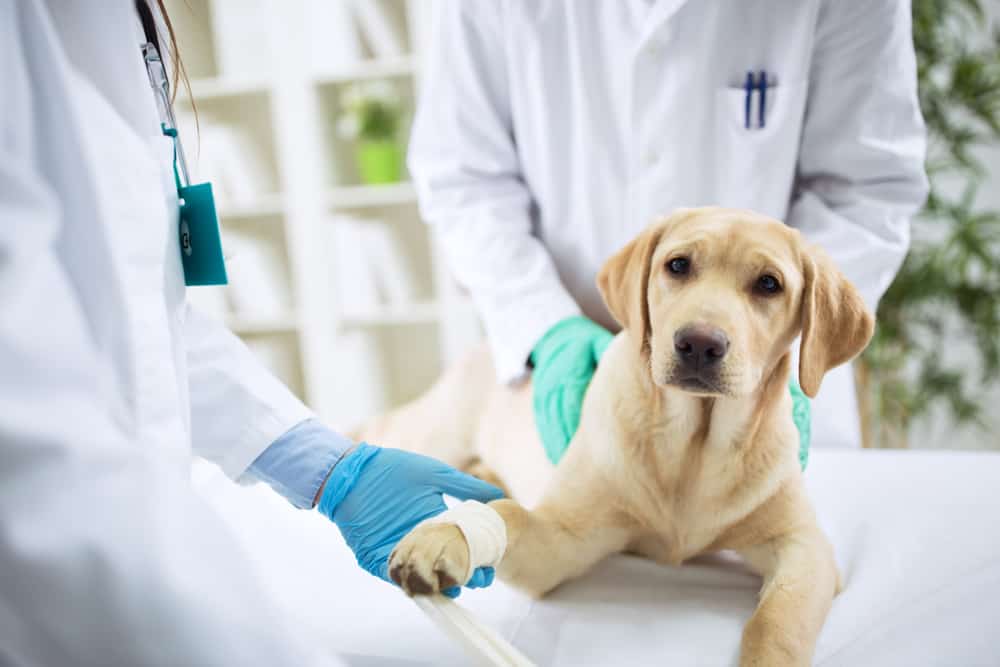Table of Contents
Why Is My Dog Limping?
Dog limping is a situation where the dog will walk on three legs with the fourth one either on the ground with a slow movement or the leg being in the air completely.
In many conditions, lameness in your dog’s leg will go unnoticeable.
But you need to see any weird walking patterns in your dog because your little one cannot speak!
The canine is seen walking uncomfortably, hopping or walking slower than its usual speed.
Your dog may be behaving in this condition due to various reasons.
Some of them may be moderate to give a home treatment while others can appear serious enough for surgery.
There are certain things you must and mustn’t do if you observe that your dog is limping.
The following are listed below:
DO’s
- Compress your dog with hot or cold packs.
- Give your dog more rest.
- Allow your dog to move freely in the house.
- Keep the dog away from soil or dust.
DON’Ts
- Force your dog to straighten its leg.
- Make your dog run or walk much.
- Exercise the dog in lameness.
- Touch or medicate the infected area on your own.
The Severity Of Dog Limping

Grade I
Not recognizable while walking.
But a slight movement is seen while trotting.
Grade II
Again not recognizable while walking but this time obvious movement is seen while trotting.
Grade III
In grade III, walking and trotting both are seen adversely affected by the leg pain.
Grade IV
The severity in grade IV is seen when the dog starts holding his leg up in the air while doing any physical task and trotting.
Grade V
This grade results in non-weight bearing lameness.
The pain forces the dog to keep its leg in the air at any given point of time.
Causes Of Lameness In Dogs

A lot of factors can cause your dog to limp.
They are further categorized in general causes of limping and disease-related causes of limping.
GENERAL CAUSES
- Sprain:
Dogs are unpredictable pets and any normal activity can make them strain their leg.
I had seen a dog twist his leg on the hill while I was on my trekking run.
- Injury On The Paw:
An injured paw is one of the most common reasons for lameness in dogs.
Glass tear, thorn tear, sports activity injury, etc are common elements to hurt the paw of your dog.
- Injury On The Nail:
Nail injuries too will disallow your pet to lay his leg on the floor.
You need to see a vet in this situation so that some medication can heal the injury and reduce the pain.
- Ligament Stretch:
Humans experience ligament stretches often while playing, stretching, exercising or during any other sporty activities.
The same is with dogs.
The ligament stretches it a minor version of ligament tear.
Consult your vet to avoid any major medication.
- Trauma:
If something affects your dog’s mental health adversely, your dog might show different behavior.
One of them can be limping.
The shock may be to such an extent that the dog may never recover from it and the limping may continue.
DISEASE RELATED CAUSES
- Hip Dysplasia:
Hip dysplasia is an inherited disease in dog breeds.
Before owning one, one must do a thorough check of any history of hip dysplasia as it is obtained genetically.
Hip dysplasia can cause severe pain to the dog in one or both the hips.
This would restrict their walking and jumping activities.
Adding to this, obesity can worsen up the situation by exerting more pressure on the hips in the form of weight.
If not, it can lead to dangerous conditions of arthritis which may require surgery
- Elbow Dysplasia:
Elbow dysplasia is a disease that causes a heredity malformation of the elbow joint.
The veterinarian needs to see the severity of the malformation before any treatment suggestion.
- Intervertebral Disc Disease:
Intervertebral discs are shock absorbers of the spine.
IVDD affects the spinal disc of the dog breed which can result in a dog limping.
Early treatment can prevent the dog from paralysis, nerve damage, loss of sensation and other incurable chronic diseases.
- Patellar Luxation:
Patella is a bone around the knee of a dog.
It has three parts.
When all these three parts aren’t lined up in order and make a different movement, it causes patellar luxation in dogs.
The disease affects the dog in a way that gives it a bowlegged appearance that would cause them to limp.
- Ruptured Cranial Cruciate Disease:
Just like how humans have the ACL, this ligament in dogs is called cranial cruciate ligament disease (CrCLD).
It is a very crucial ligament of the body which acts as a stabilizer.
The function of this ligament includes shock absorption, position-sensing, and load-bearing.
Any tear or a stretch of the same will cause lameness.
It is important to give advisory treatment for the same.
- Canine Monocytic Ehrlichiosis:
Canine monocytic ehrlichiosis disease in dogs is caused because of the brown dog ticks that are generally seen on the skin of dogs commonly the German shepherd dog.
A specific bacterium named Ehrlichia Canis dilutes a certain type of white blood cell in the dog’s body which will target the body’s normal functioning.
The dog is likely to limp in this condition.
- Lyme Disease:
Lyme disease in dogs is caused by certain types of ticks through a tick bite.
The bacterium transmitted through this bite is very harmful to dogs as it can cause a default in joints and other organs of the body.
- Panosteitis:
Panosteitis is a bone disease painful to the legs of large-sized dogs like the Rottweiler.
Excessive pain can cause the dog to limp and the only way to get rid of it is lots of rest and care.
- Fracture:
A fracture in any part of the leg or the joints will make you doggo limp.
Fractures can happen from any physical injury like running, jumping in for a catch (Siberian Huskies catching rabbits), turning around the body, carrying weights, etc.
- Immune-Mediated Polyarthritis In Dogs:
The immune system of the canine’s body gets prone to diseases that cause severe pain and swelling in the joint and muscle tissues.
The system sends white blood cells around the knee covering.
This process is not required near the knee and the aftereffect of this is seen by the dog walking inappropriately.
- Degenerative Myelopathy:
If your dog is seen dragging its body or wobbling while walking, he/she is likely to be suffering from degenerative myelopathy.
Aging dogs have higher chances of suffering from this disease.
This disease is a condition where older dogs develop problems in the spinal cord and the affected part of the dog loses sensation.
- Cancer:
Regardless of the body, it targets, cancer is known for the growth of abnormal cells.
Unfortunately, dogs too are prone to this life-taking disease.
In fact, you will be surprised to know that most dog deaths after the age of 10 are caused by cancer.
The abnormal growth in the cells of the body will result in the malfunctioning of different body parts.
One of the results of it can be limp in dogs.
Treating Your Dog’s Limping

MEDICAL TREATMENTS

Acute diseases need medical treatments.
Your veterinarian is the best person to tell you about which disease needs what kind of treatment.
However, as a responsible pet owner, you would want to know what it takes to treat your loving companion.
It’s good to know what to and what not to expect from the vet before you schedule a visit.
There are possibilities that your dog make only require rest or some homely remedies.
But you need to be prepared for the worst and hope for the best.
Certain chronic diseases come with age.
These cannot be treated with any medication while a few are treatable.
Some of them would probably require surgery while others can settle with injections and medicines.
- Cost Of Medical Treatment:
Initial physical examination is approximately worth 50-60 dollars depending on the vet.
Anything that appears serious to the vet will then need an MRI or an X-Ray test that sums up to 150 dollars.
Minor treatments to the same would need basic treatment for about 50-60 dollars.
But anything that looks goofy will charge you nothing less than 500 dollars to 1,500 dollars which is the surgery fees.
Ahead of this other medical and non-medical expenses post the surgery is estimated to be of 500 dollars.
However, the size of the dog is will reflect the total cost of the treatment.
HOME-BASED TREATMENTS (HOME REMEDIES)

- Cold Or Hot Compress:
Cold compress is an excellent remedy for the dog to feel at ease while walking.
A hot compress can also be given but care needs to be taken with regards to the hotness of the compress.
- Pain Relief Massage:
Dogs love massages.
They will try to lick or bite your hand during this process but that does not signal to stop the cuddly massage.
The limping in dogs can be treated at home with a gentle massage.
However, if the pain gets severe avoid massages and see your vet immediately.
- Reducing Carbohydrates Intake:
Food items that include carbohydrates such as wheat, corn, milk, grains should be discouraged at this time.
These will not help in repairing the affected tissues.
On the contrary, it will increase the pain.
- Increasing Protein Intake:
Protein is what the dog needs.
Meat protein should be substituted in place of grain protein.
It will be highly beneficial to stop the dog from limping.
- Use Of Crate:
If you force your dog to walk on its own, the condition can get out of hand.
Your dog might refuse to walk or might even tear a muscle that had only stretched.
It is advisable to use the crate for carrying and resting purposes.
Dogs Faking Limping

Yes, you read it right. Your dog can fake a limp.
Dogs being dogs love the attention of its owner.
Your dog would remember the time you showed extra love and care while the dog was on its limping pain.
This would make him/her pretend to limp around the house so that you could hold it tight in love and sympathy.
Human cuddles are their favorite thing and faking a limp for the same does not seem a big deal, does it?
Dog limping is very common in police dogs, and if you have any one of these police dogs there is a high chance he is not faking it.
That’s it from our side.
We would also love to hear your stories and thoughts over your dog limping experience.
Write down to us in the comment section below!
Happy petting to you!













[…] pug pooch can be seen limping and moving around in […]
[…] can lead to dog limping as well in some […]
I didn’t know paw injuries were among the most common causes of limping in dogs. When I took my dog to the park last week, I noticed that she was trying to avoid putting pressure on one of her front legs. It may be best to see a vet that can identify why my dog is limping.
[…] severe cases, grave injuries can be caused or lameness can occur. In this scenario, the nails could grow relentlessly, sometimes even up to a length that […]